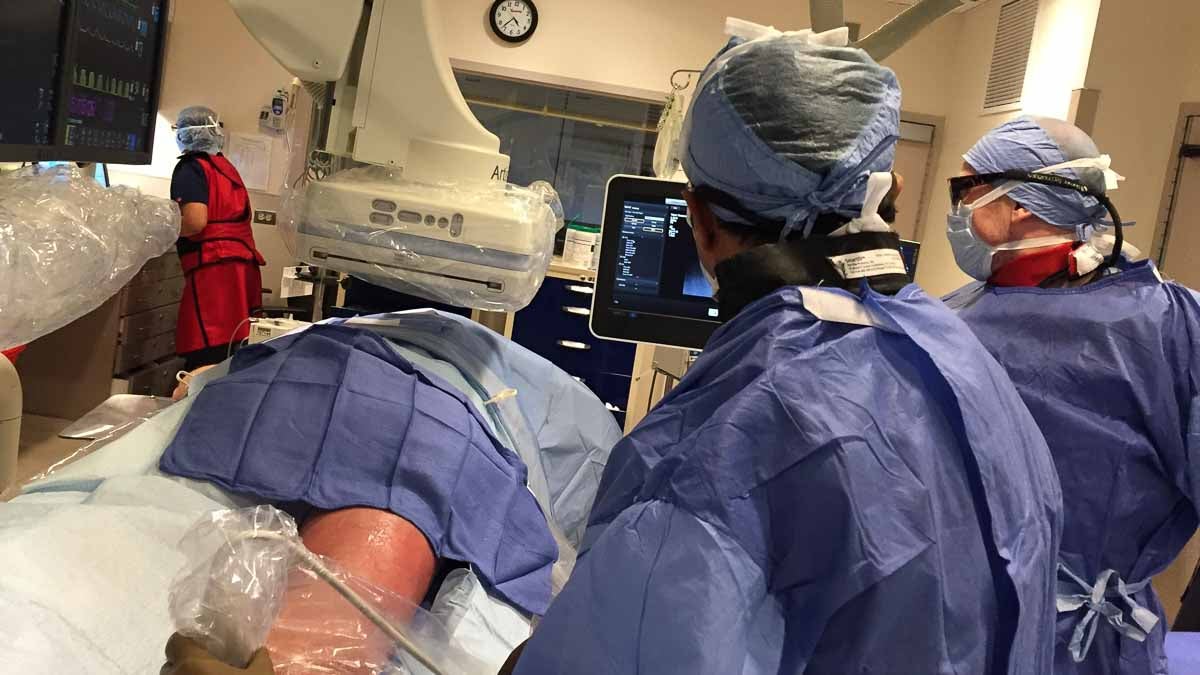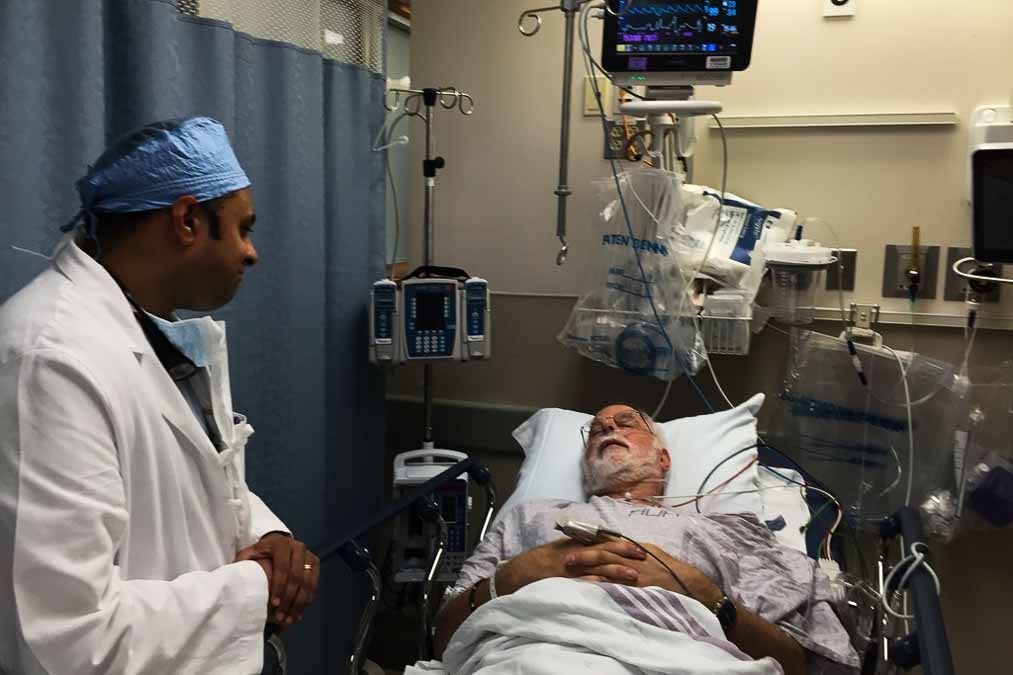Catching a killer that hides deep in our veins
Listen
Dr Deepak Sudheendra and his staff look at images of the clot. (Maiken Scott/WHYY)
Effective public health messages have to be short and clear: Smoking kills. Don’t drink and drive. Buckle up for safety. Eat a rainbow. Get your rear in gear (that’s for colonoscopies.)
They are simple messages that fit on billboards or in a tweet – to change behaviors – or to recognize potentially deadly symptoms.
Take, for example the campaign for stroke awareness that uses the acronym FAST, and is accompanied by pictures.
“F” stands for face – is it drooping? “A” stands for arm – is it sagging? “S” is for speech – is it slurred? And “T” stands for time – meaning, it’s time to call 9-11.
This campaign came from England, where it was hailed as one of the most successful public health campaigns to date.
A complicated killer
But, when a disease process and the symptoms are complicated – raising awareness is more challenging. That’s certainly true for one of the major killers of Americans: pulmonary embolism. It kills more than 60-thousand people annually. This year, it claimed the life of a trusted and familiar voice for public radio listeners, Craig Windham. Windham delivered the news as an anchor and correspondent for National Public Radio for over two decades. He was 66 years old, and visiting his brother when he died of a pulmonary embolism.
With this condition, public awareness lags behind. And there are a few factors that could explain that. Pulmonary embolisms happen in the lung – but the problem usually starts in the leg, so, that’s complicated to explain – and, there are wildly different risk factors involved.
It’s not a pulled calf muscle
Often, people have symptoms for quite some time, but have no idea what they are dealing with. Take Paul Yu, for example. He’s a dentist, in his forties, slim, athletic, healthy. He likes to travel, but a trip he took last year almost ended up being his last.
“I was on a flight from D.C. to Istanbul, a 12-hour flight,” recalled Yu. “I pretty much had two glasses of wine and passed out.”
When he landed in Turkey, he noticed a weird pain in his calf. He had trouble walking, and it got a little worse every day. He continued to limp through Istanbul, best as he could. A few days into his trip, his leg became so swollen, it freaked him out. “It looked angry, twice the size of the other leg, and was visibly getting worse.”
Even though as a dentist, he had some medical training, Yu had no idea what he was dealing with. He started to text pictures of his leg to his doctor friends in the US. They said it was no big deal. But his pain got so bad he went to a local hospital. There, doctors diagnosed a blood clot, or Deep Vein Thrombosis- DVT for short – in his leg, and put him on blood thinners immediately.
“I remember the doctor there telling me if this clot had gone into my lung, it was game over.”
Here’s what could have happened to Yu – at any time while he had this clot.
If you picture blood flowing through your body – the arteries carry oxygenated blood from your lungs and heart to your other organs, arms and legs. The veins take the de-oxygenated blood back up. So, if you have a blood clot in your leg and it breaks off, it is carried along, up to your lungs. There it creates a blockage. The heart tries to pump against that, to keep the blood flow going, and it builds up more and more pressure. Patients will have chest pain and shortness of breath. If there’s no quick intervention, the heart fails.
Blood thinners don’t break up the clot right away, but they prevent it from getting worse, and from breaking off and moving into the lungs. In Yu’s case, he was cleared to fly home to get surgery, but the whole time on the plane, he felt like he had a ticking time bomb in his leg. “I prayed. I never pray, I was very, very scared.”
Where medicine and plumbing meet
Back in the U.S., Paul Yu went to the emergency room, where he met Deepak Sudheendra, a surgeon in the interventional radiology department at the University of Pennsylvania in Philadelphia, and an expert in anything affecting veins.
At the hospital, everybody calls him “Dr. Sudee” – his patients, the nurses, his office staff – he has short black hair and a friendly smile. With a white coat over scrubs and a cap, he looks every bit a surgeon, but he loves using plumbing metaphors when talking about veins and blood clots. “So, it’s similar to stopping up a pipe. If you stop up a pipe, the water that is coming down, really has nowhere to go. It is trying to get past a blockage.”
Sudheendra and Yu discussed different options for treatment. One option was to keep taking blood thinning medication, and to wait for the clot to eventually dissolve. But, that can take months – of being in pain and unable to walk. Instead, Yu opted to have his clot broken up and sucked out in a procedure – which he says resulted in immediate relief. “I remember leaving the next day and going out to eat, walking on my leg!”
Do physicians know the warning signs?
Another one of Sudheendra’s patients had just had a blood clot removed from his leg. Sudheendra stopped by the recovery area to debrief him about the outcomes.
Michael Rubinstein was resting on his hospital bed, he is also a physician, a neurologist. He had had a bout with severe vertigo for six days, and was bedridden. When he was finally able to get up again, he noticed a pain in his leg, but he ignored the pain for several days. “I was very surprised that I could have a DVT,” he admitted. “Even though I’m a 60 year old, I envision myself as a 40 year old. I am very fit, I just climbed Mount Kilimanjaro!”

Physician Michael Rubinstein lies in bed talking to his doctor, Deepak Sudheendra. (Maiken Scott/WHYY)
Sudheendra wasn’t surprised to hear a fellow physician admit that he didn’t know much about blood clots. He feels that veins – and their diseases – are a bit of a stepchild in medicine.
“I remember back when I was a medical student, in anatomy class, we would dissect the human body, and we’d be asked about all of the arteries in the human body, but we were not asked about the veins at all,” he said.
Sudheendra believes that attitude hasn’t changed.
In another patient bay, Charles Steinbach was waiting for his vein procedure. His right leg was swollen and red, and he was visibly in a lot of pain. Steinbach also has brain cancer, and had trouble recalling why he was there. “I’m here for a procedure, you have to ask my wife because I don’t remember.”
Steinbach had a clot that had grown from his ankle to his hip. His wife, Suzanne, uses plumbing analogies to describe his upcoming procedure – probably courtesy of Dr. Sudheendra. “They are going to roto-rooter it out, hopefully.”
Knowing the risk factors
Why these clots form is a bit of a mystery – but cancer is one of the big risk factors. Some people are genetically prone to clots. They can form during pregnancy. And – clots very often appear after surgeries. In fact – Pulmonary Embolism is the number one preventable cause of death in hospitals.
A few years ago, hospitals started to incur financial penalties when blood clots happen post-surgery. Many are taking a lot of care to avoid them – That’s why patients now get calf-sleeves while they’re recovering from surgery, they inflate and deflate – and keep the blood moving up from your legs.
Some hospitals have started to form special pulmonary embolism response teams – physicians from different specialities that swoop in like a SWAT team when patients have clots in their lungs and every second counts.
Steinbach has been wheeled into the small operating suite. He’s sedated, and lying on his belly.
Sudheendra tells me that a lot of doctors wouldn’t do a procedure on this patient because his system was weakened by cancer, and there could be complications. But, he told me that Steinbach had been in so much pain, he asked doctors to amputate his leg.
Sudheendra was looking at grainy black and white scan images of the vein the entire time – trying to gain access to get to the clot. “I have got the ultrasound transducer here, I am pressing on his leg, and the vein should squash like a pancake, but it’s still nice and round, and that’s because it’s filled with clog. You can’t compress it.”
Sudheendra was looking to gain access to the vein, to insert a catheter. “And we spray some clot-busting medication which is very powerful, it will dissolve the clot,” he explained.
And then comes the roto-rooter type of device, it breaks the pieces up further, and then suctions everything out.
About 50 percent of patients – especially those with big blood clots – develop complications, and recurring clots. But for now, the procedure proved to be a success. Steinbach left the hospital a few days later, not in pain, and able to walk. It’s that kind of relief that keeps Sudheendra going. He jokingly calls himself a vein ambassador, always talking about the importance of healthy veins.
On long flights, he wakes his wife up every two or so hours to get up and move around. She’s not a fan of that, but he says it’s helpful in preventing clots.
Pulmonary embolism isn’t always preventable. Sometimes, they happen really quickly, and without any warning. But, Sudheendra says – if physicians and patients recognized the symptoms when they are present – like swelling and redness in the leg – and if they knew the risk factors, it would prevent much suffering, and many deaths.
WHYY is your source for fact-based, in-depth journalism and information. As a nonprofit organization, we rely on financial support from readers like you. Please give today.




